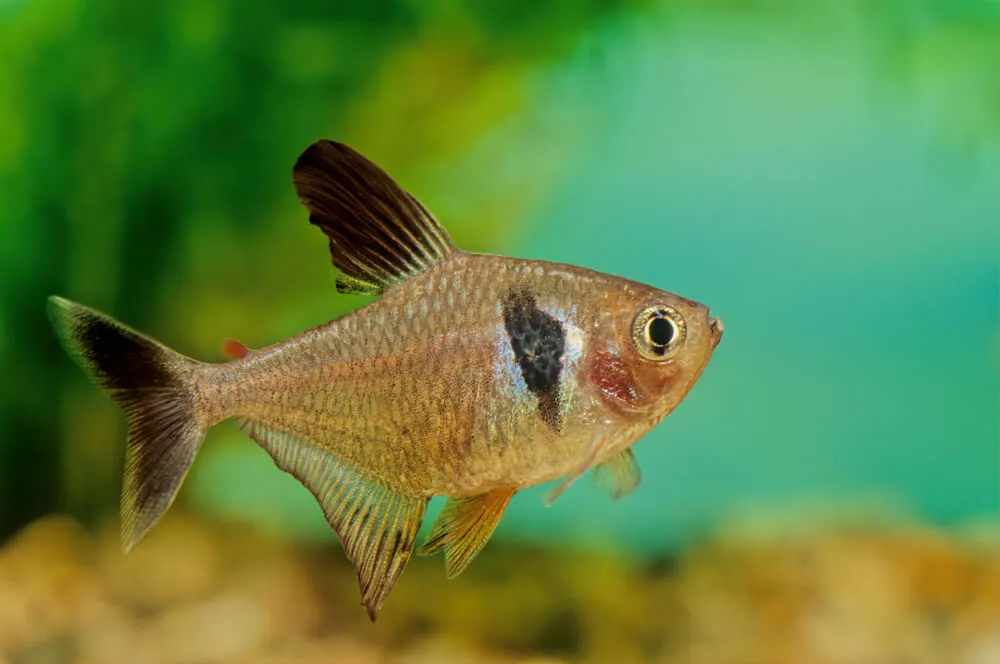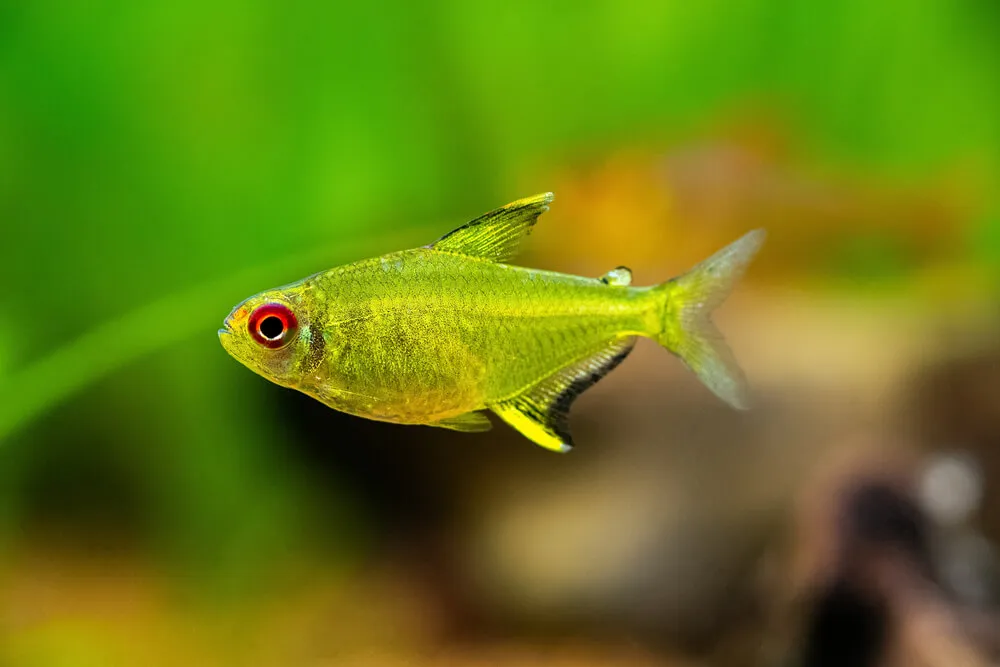All About Black Phantom Tetras: Care, Feeding and Tank Setup

You are about to embark on an exciting journey into the mesmerizing world of the Black Phantom Tetra. With its striking black-colored body and delicate fins, this beautiful fish is a true jewel among aquarium enthusiasts. In this article, we will uncover the captivating traits and behaviors of the Black Phantom Tetra, shedding light on why it is a popular choice for both novice and experienced fishkeepers alike. So, get ready to dive deep into the enchanting world of the Black Phantom Tetra and discover what makes it a fascinating addition to any aquarium.
Appearance
Coloration
The Black Phantom Tetra is named for its striking coloration. It has a dark, almost black body with a vibrant red or orange tail. The combination of these two contrasting colors creates a visually stunning fish that will add a pop of color to any aquarium.
Size
The Black Phantom Tetra is a small fish, growing to just about 2 inches in length when fully mature. This makes them a suitable choice for smaller aquariums or for hobbyists who prefer smaller fish species.
Fins and Body Shape
In addition to their unique coloration, Black Phantom Tetras have elegant fins and a streamlined body shape. Their fins are long and flowing, adding to their overall beauty. The body is slender and slightly elongated, allowing them to swim swiftly through the water.
Habitat
Natural Range
The Black Phantom Tetra is native to the rivers and streams of South America, specifically the Paraguay River basin. They can be found in areas with dense vegetation and slow-moving or still waters. In the wild, these fish thrive in warm, tropical environments.
Aquarium Requirements
To provide the best possible living conditions for Black Phantom Tetras, it is important to replicate their natural habitat as closely as possible. They prefer aquariums with plenty of plants and hiding spots, as well as areas with both open water and densely vegetated areas.
Tank Mates
Black Phantom Tetras are generally peaceful fish and can be kept with a variety of tank mates. However, they may become stressed or intimidated by more aggressive or larger fish species. It is best to choose tank mates that are of similar size and temperament to ensure a harmonious community tank.
Feeding
Diet
In the wild, Black Phantom Tetras are omnivorous, meaning they eat both plant matter and small aquatic organisms. In captivity, they can be fed a varied diet consisting of high-quality flakes or pellets, supplemented with live or frozen foods such as brine shrimp or bloodworms.
Feeding Schedule
It is recommended to feed Black Phantom Tetras small amounts of food several times a day. This will help mimic their natural feeding patterns and prevent overeating. Feed only what they can consume within a few minutes to ensure they receive the proper nutrition.
Live vs. Prepared Foods
While Black Phantom Tetras can thrive on a diet of prepared foods alone, incorporating live or frozen foods into their diet is beneficial. Live or frozen foods provide additional nutrients and can help stimulate their natural foraging behavior.
Behavior
Social Behavior
Black Phantom Tetras are social fish and should be kept in groups of at least 6 individuals. They thrive in the presence of their own kind and will display more natural behavior when kept in a group. They are generally peaceful and can be housed with other peaceful species.
Activity Level
These tetras are active swimmers and will often dart around the aquarium, especially when they feel secure and comfortable in their environment. Providing a well-decorated tank with plenty of swimming space will encourage their natural behavior and enhance their activity level.
Breeding Behavior
Breeding Black Phantom Tetras can be a rewarding experience. They are egg-layers and will scatter their eggs among plants or other surfaces in the aquarium. The parents do not provide care for the eggs or fry, so it is important to remove them from the main tank to prevent predation and ensure the survival of the young.
Tank Setup
Tank Size
A minimum tank size of 20 gallons is recommended for a small group of Black Phantom Tetras. This will provide them with enough swimming space and allow for the inclusion of plants and hiding spots. A larger tank size is advisable for larger groups or for keeping them with other fish species.
Water Parameters
Black Phantom Tetras prefer slightly acidic to neutral water conditions. The temperature should be kept between 75-82°F and the pH level should be in the range of 6.0-7.5. It is important to regularly monitor and maintain water parameters to keep the fish healthy and thriving.
Aquarium Decor
In order to create an ideal environment for the Black Phantom Tetra, it is important to include plenty of live or artificial plants in the tank. These tetras appreciate areas to hide and explore, so driftwood, rock structures, and caves make great additions to their tank. A dimly lit tank with a dark substrate can also help enhance their coloration.
Water Conditions
Temperature
Black Phantom Tetras prefer a tropical water temperature ranging from 75-82°F. It is important to use a reliable aquarium heater to maintain a consistent temperature within this range, as fluctuations can stress the fish and compromise their health.
pH Levels
The ideal pH range for Black Phantom Tetras is between 6.0-7.5. It is important to regularly test and adjust the pH level as necessary to ensure the well-being of the fish. Avoid drastic pH swings, as this can be detrimental to their health.
Water Hardness
These tetras thrive in slightly soft to moderately hard water. Aim for a water hardness level of 5-15 dGH to mimic their natural habitat. Regular water changes and the use of appropriate water conditioners can help maintain the desired water hardness.
Breeding
Breeding Conditions
To encourage breeding in Black Phantom Tetras, provide them with a well-planted tank with plenty of hiding spots and a spawning mop or fine-leaved plants, where the female can scatter her eggs. Maintain pristine water conditions and consistent temperatures within their preferred range to promote successful breeding.
Egg Laying
When ready to breed, the female Black Phantom Tetra will scatter her adhesive eggs among the plants or spawning mop. The eggs are small and transparent, making them difficult to spot. It is advisable to use a separate breeding tank to ensure the survival of the eggs and fry.
Caring for Fry
Once the eggs hatch, the fry will be extremely tiny and vulnerable. They will need to be fed infusoria or other suitable food for the first few days before transitioning to baby brine shrimp or finely crushed flakes. Frequent water changes and careful monitoring of water parameters will help ensure the survival and growth of the fry.
Diseases
Common Diseases
Black Phantom Tetras are generally hardy and less prone to diseases compared to some other fish species. However, they can still be susceptible to common fish diseases such as ich, fungal infections, and fin rot. Keeping the aquarium clean and providing proper nutrition and water conditions can help prevent these issues.
Preventive Measures
To prevent diseases, it is essential to maintain good water quality by performing regular water changes and testing the water parameters. Quarantine new fish before introducing them to an established tank to minimize the risk of introducing diseases. Avoid overcrowding and provide a balanced diet to boost the immune system of the fish.
Treatment Options
If a disease does occur, prompt action is necessary to ensure the health of the fish. Consult with a veterinarian or a knowledgeable fish keeper for appropriate treatment options. Medications, water conditioners, and increased water changes may be necessary to address the specific disease.
Availability
Pet Stores
Black Phantom Tetras are commonly available in pet stores that specialize in freshwater fish. With their striking coloration and peaceful nature, they are often sought after by hobbyists looking to add a vibrant touch to their aquarium.
Online Sources
Numerous online retailers offer Black Phantom Tetras for purchase, providing convenience and a wider selection for hobbyists. It is important to use reputable sources and consider the shipping and handling practices of the retailer when purchasing fish online.
Pricing
The price of Black Phantom Tetras can vary depending on factors such as size, availability, and location. On average, they are reasonably priced and offer good value for their striking coloration and peaceful temperament.
Conclusion
Suitability for Hobbyists
Black Phantom Tetras are an excellent choice for hobbyists of all experience levels. They are relatively easy to care for, have stunning coloration, and are compatible with a wide range of tank mates. Their small size makes them suitable for smaller aquariums and their peaceful nature adds to their appeal.
Challenges of Keeping Black Phantom Tetra
While generally hardy, Black Phantom Tetras can be sensitive to poor water conditions or sudden fluctuations in water parameters. Maintaining consistent water quality and ensuring proper nutrition are key to their well-being. Additionally, successful breeding can be challenging, requiring specific conditions and careful monitoring.
Overall Appeal
With their striking black and red coloration, graceful fins, and active behavior, Black Phantom Tetras are sure to capture the attention of any aquarium enthusiast. Their peaceful nature and compatibility with a variety of tank mates make them a popular choice for both beginner and experienced hobbyists. Adding a group of Black Phantom Tetras to your aquarium will not only enhance its aesthetic appeal but also provide you with hours of enjoyment observing their natural behavior.




